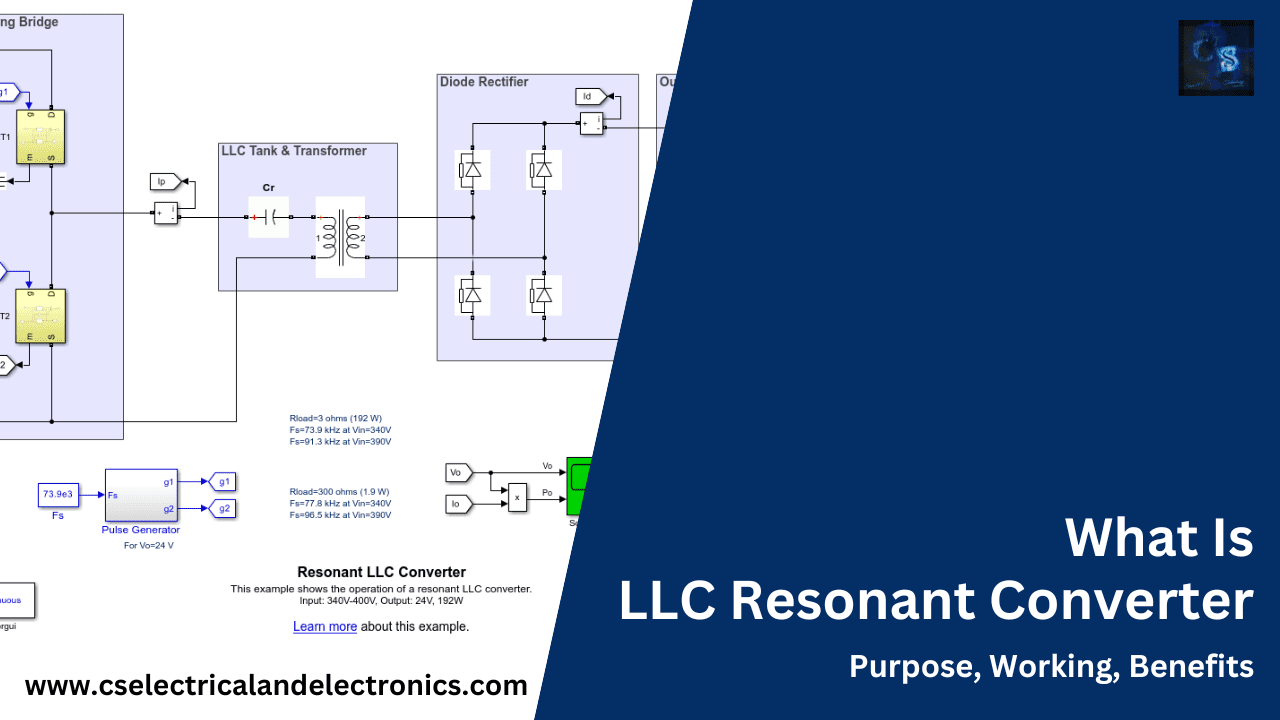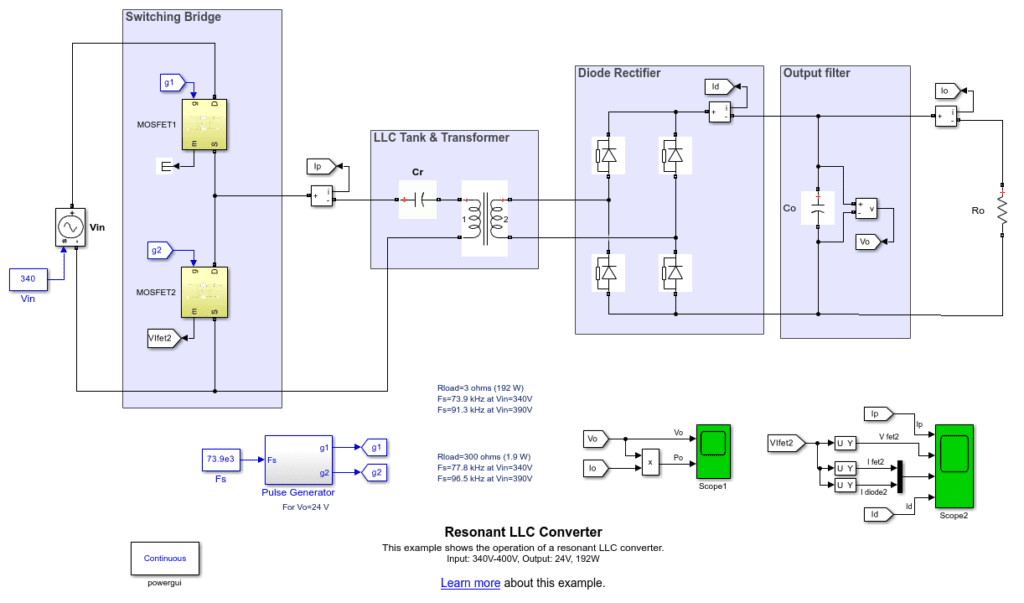What Is LLC Resonant Converter, Purpose, Working, Advantages
Hello guys, welcome back to our blog. Here in this article, we will discuss what is LLC converter, its purpose of LLC resonant converter, its working, and the advantages & disadvantages of an LLC resonant converter.
If you have any electrical, electronics, and computer science doubts, then ask questions. You can also catch me on Instagram – CS Electrical & Electronics.
Also, read the following:
- Scientists Develop An AI Model That Can Read The Human Mind
- What Is Python Scripting, Purpose, Applications Of Python Script
- Top 20 Ocean Technologies That Will Blow Your Mind
LLC Resonant Converter
A typical kind of power converter seen in electrical equipment and power supply is the LLC resonant converter. It is renowned for being highly effective and having the capacity to regulate both voltage and current. The letters “LLC” stand for the converter’s three major parts: inductor (L), capacitor (C), and capacitor (C).
The resonant frequency is the underlying idea behind how the LLC resonant converter works. To achieve effective power conversion, it makes use of the resonance between the two capacitors (C) and the inductor (L). When the voltage across the resonant tank is zero, the converter switches the power to the load. An inductor and capacitors make up the resonant tank circuit.
The LLC resonant converter’s capacity to function at high frequencies is one of its main features. It decreases the size and weight of passive components like inductors and capacitors by using high-frequency switching. This qualifies it for uses that call for portable, lightweight power supplies.
Compared to other converter types, the LLC resonant converter has a number of advantages. It offers great efficiency across a broad load range, reducing power losses and enhancing total energy efficiency. The converter is excellent for applications with a range of load circumstances since it also has outstanding voltage regulation and transient responsiveness. In contrast to conventional converter topologies, it also produces less electromagnetic interference (EMI).
The interplay between the inductor and capacitors might make controlling an LLC resonant converter challenging. To ensure adequate regulation and preserve stable functioning, a variety of control techniques, including frequency control, phase-shift control, and pulse width modulation (PWM), are used.
Many different applications, including power supplies for computers, servers, televisions, and electric cars, make extensive use of LLC resonant converters. They are a desirable option for situations where size and energy efficiency are essential factors due to their excellent efficiency and performance traits.
Overall, the LLC resonant converter, which combines the benefits of resonant circuits with high-frequency switching, is a flexible and effective power converter. It is a well-liked option in many electronic devices and power supply systems due to its capacity to deliver effective power conversion, voltage management, and compact size.
Purpose of LLC Resonant Converter
In order to efficiently convert and regulate electrical power in various electronic devices and power supply systems, the LLC resonant converter is used. The following are its primary goals:
Power Conversion Effectiveness: The LLC resonant converter is built to maximize power effectiveness. It accomplishes this by using resonant tank circuits, which reduce power losses and boost overall efficiency by storing and transferring energy between the inductor and capacitors. This is especially useful for applications like data centers, electric cars, and renewable energy systems where energy efficiency is a key consideration.
Voltage Regulation: The LLC resonant converter may provide exact voltage regulation, making sure that the output voltage remains constant and within predetermined bounds. This is crucial for electronic devices like computers, servers, and delicate equipment that need a steady and dependable power source. By adjusting the switching frequency, phase-shift, or pulse width modulation (PWM) approaches, the converter provides voltage regulation.
Operation Over a Wide Load Range: The LLC resonant converter is built to perform well under various load scenarios. It can adjust to shifting power demands because it keeps high efficiency and voltage regulation even when the load changes. Due to its adaptability, it can be used for applications with variable and unpredictable loads, such as those in computer systems.
Reduced Electromagnetic Interference (EMI): The LLC resonant converter reduces the amount of EMI produced during the power conversion process. It minimizes switching noise and electromagnetic emissions by working at high frequencies and applying soft-switching techniques. This is crucial for applications that need low EMI levels to meet regulatory requirements and guarantee the proper operation of delicate electronic components.
Compact and Lightweight Design: The LLC resonant converter enables the creation of a small and light power supply. It is possible to employ more compact passive parts, including inductors and capacitors, because it operates at high frequencies. In applications with little space, such as portable electronics, consumer electronics, and automotive applications, this is helpful.
The LLC resonant converter’s overall goal is to provide dependable and efficient power conversion with wide load range operation, low EMI, and small size. Its characteristics make it a popular option for a variety of applications, from small electrical gadgets to massive power systems.
Working of LLC Resonant Converter
In order to perform effective power conversion, an LLC resonant converter relies on the interaction of its three main parts: the inductor (L), capacitor (C), and capacitor (C). Here is a detailed description of how it works:
Operation in the Off-State: The converter’s power switches are initially off. The converter’s input side and output side are physically separated from one another.
Soft Start: A soft-start circuit gradually raises the voltage provided to the converter as soon as it is powered on. The components are safeguarded and excessive inrush current is avoided.
After the soft-start period has ended, the power switches on the primary side are turned on to begin charging the resonant tank. This links the input voltage source to the inductor (L) and capacitor (C)-based resonant tank circuit.
Resonant Tank Discharge: As soon as the power is turned on, electricity starts to flow through the circuit for the resonant tank. The inductor and capacitors are charged as a result of the increase in energy storage.
Zero Voltage Switching (ZVS): The power switches turn off when the voltage across one of the capacitors reaches zero. By doing this, switching losses are minimized because switching is carried out when the voltage across the switches is at its lowest. Zero voltage switching (ZVS) is the name of this method.
Energy Transfer and Resonant Tank Discharge: When the power switches are removed, the resonant tank circuit begins to discharge. A transformer is used to move the inductor’s energy storage from the primary side of the converter to the secondary side. When the voltage across the resonant tank circuit is at its lowest, this energy transfer takes place.
Rectification and Output: Using diodes, the secondary side of the converter rectifies the transformer’s AC voltage into a DC voltage. The smoothed-out rectified DC voltage is then filtered to provide a regulated DC output voltage.
Feedback and Control: A feedback circuit is used to monitor the output voltage and provide a control signal that modifies the converter’s operation. The operating frequency, phase-shift, or pulse width modulation (PWM) are adjusted by this control signal to maintain the desired output voltage and guarantee steady operation.
Repeat Operation: To continually provide the load with regulated power, the LLC resonant converter repeats the previous procedures. To maintain effective and stable functioning, the switching frequency and other control parameters are dynamically modified based on the load conditions.
It’s crucial to remember that the specific control method and implementation specifics may change based on the LLC resonant converter’s design and requirements. To regulate the functioning of the converter and achieve the desired performance, a variety of control approaches, including frequency control, phase-shift control, or PWM, can be used.
Advantages & Disadvantages of LLC Resonant Converter
The LLC resonant converter has some limits as well as a number of benefits. Let’s first examine the benefits:
LLC Resonant Converter Benefits
High Efficiency: The LLC resonant converter reaches efficiency levels that are high, frequently exceeding 90%. The soft-switching capability of the resonant tank circuit lowers power losses and boosts total energy effectiveness. This qualifies it for use in data centers, electric vehicles, and renewable energy systems, among others, where energy efficiency is a top issue.
Wide Load Range: The LLC resonant converter may function effectively under a variety of load circumstances. It offers flexibility in adapting to dynamic load fluctuations since it maintains high efficiency and voltage regulation even when the load fluctuates. This is advantageous in applications with different power requirements, such as computer systems and industrial machinery.
The LLC resonant converter has outstanding voltage regulation capabilities. Even with considerable load variations or changes in input voltage, it can keep the output voltage steady. This qualifies it for uses that call for accurate and dependable voltage regulation, such as in delicate electronic equipment and machinery.
Reduced Electromagnetic Interference (EMI): Compared to some other converter topologies, the LLC resonant converter generates lower levels of EMI. Electromagnetic compatibility (EMC) standards can be more easily met thanks to the soft-switching operation and high-frequency switching, which also reduces the need for extra EMI filtering components.
Compact Size and Weight: The LLC resonant converter’s high-frequency operation enables the use of smaller passive elements like inductors and capacitors. Compact and lightweight power supply designs are produced as a result, which is helpful in applications with weight or space restrictions, such as portable electronics, consumer goods, and automotive systems.
The LLC resonant converter has certain drawbacks despite its benefits:
LLC Resonant Converter drawbacks:
Complex Control: The interaction between the inductor and capacitors can make controlling an LLC resonant converter challenging. Careful control strategies and control circuit design are necessary to achieve the highest levels of performance and stability. For inexperienced designers in particular, this intricacy may make design and implementation challenges more difficult.
Higher Component Count: Compared to certain other converter topologies, the LLC resonant converter often requires a higher number of components. Multiple inductors, capacitors, and transformers can make a circuit more complex, cost more money, and take up more space on the PCB.
Limited Operating Frequency Range: Due to the properties of the resonant tank circuit, the LLC resonant converter has a restricted operating frequency range. Operating outside of this range could lead to instability or lower efficiency. To guarantee optimal performance, careful frequency selection, and design are necessary.
Costlier: Compared to simpler converter topologies, the LLC resonant converter may have higher production and component prices due to its added components and complexity. This might be taken into account in applications with tight budgets.
It’s crucial to remember that the benefits and drawbacks listed above are typical traits of LLC resonant converters. Based on the unique requirements and limits of the application, particular implementations and designs may have extra benefits or drawbacks.
I hope this article may help you all a lot. Thank you for reading.
Also, read:
- 100 + Electrical Engineering Projects For Students, Engineers
- 1000+ Electronics Projects For Engineers, Diploma, MTech Students
- 1000+ MATLAB Simulink Projects For MTech, Engineering Students
- 50 Advanced Level Interview Questions On CAPL Scripting
- 500+ Embedded System Projects For Engineer, Diploma, MTech, PhD
- 500+ Projects For Diploma Electrical, Electronics Student, Diploma Project
- 8051 Microcontroller Timers, TCON Register, TMOD Register
- A Complete Guide To FlexRay Automotive Protocol


